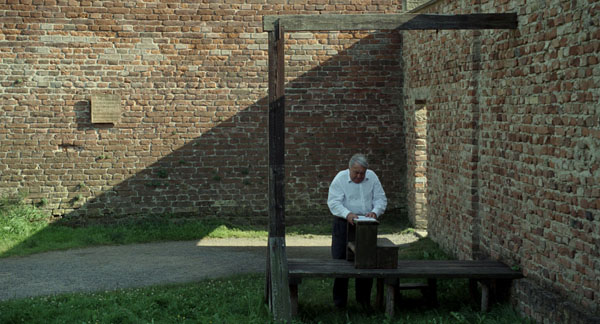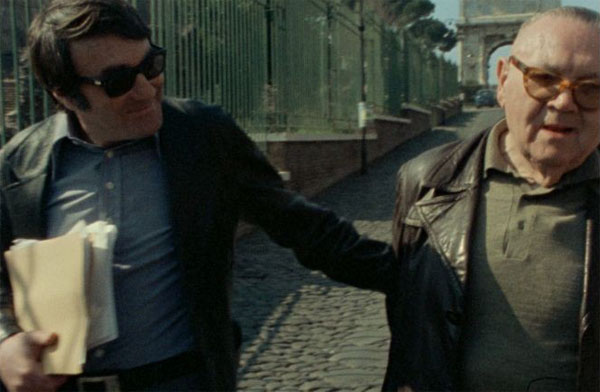“In almost four hours of relentless interviews and reflection,” writes Deborah Young in the Hollywood Reporter, “filmmaker Claude Lanzmann returns to the ghostly lands of Shoah, his 9½ hour documentary which has been a watershed for human knowledge about the Holocaust since it appeared in 1985. The Last of the Unjust refers to Benjamin Murmelstein, the third and last ‘Jewish Elder’ appointed by the Nazis to run the Theresienstadt ghetto camp in Czechoslovakia, interviewed by Lanzmann in Rome in 1975. Accused by some of having been a collaborator, including historian Gershom Scholem who called for him to be hanged, he is fully vindicated in the film as a courageous man who uses his prodigious memory and dazzling intelligence to reconstruct the terror he lived through and in someway influenced. The forcefulness of Murmelstein’s personality carries the audience through some longeurs in a powerful, often painful revisitation which is bound to unleash new debate on the role of Jews who worked for the Nazis.”
On the day before Cannes opened, the Guardian ran Agnès Poirier‘s profile of Lanzmann, who, years after that 1975 interview, “decided not to include Murmelstein in Shoah. Speaking in his Paris apartment, a stone’s throw from the catacombs where his fellow teenage members of the Resistance oversaw the liberation of Paris in 1944, Lanzmann explains why. ‘Shoah was epic and told a relentless tragedy. Murmelstein had no place in it. If I had included him, Shoah would have had to be 20 hours long.'” Further in:
The Last of the Unjust is a remarkable film. Lanzmann has woven his 1975 interviews into visits to the places where the events described occurred: Austria, Poland, Israel and the Czech Republic. We leave the youthful 50-year-old Lanzmann, chain-smoking on that balcony in Rome, to find him, 38 years later, white-haired but as imposing as ever, on the platform of Nisko station in Poland, where the first deported Jews arrived in October 1939. Over sweeping views of the Czech city of Terezín today, we hear Murmelstein saying: “Theresienstadt was a lie, an enormous lie. A seaside resort for elderly Jews, they said. As if. Jews were supposed to live in family boarding houses, except they were cramped in derelict attics. Jews were supposed to enjoy a well-deserved retirement, except they were left to rot and die. Everything was a lie. And we had to live that lie for the world.” Many Austrian and German Jews gave their savings to go and live there. “Theresienstadt,” says Lanzmann, “was human in appearance only. It was the worst kind of concentration camp, with blackmail, lies and naked violence.”
Writing for Grantland, Wesley Morris notes that, in the film, Murmelstein, who died in 1989, “details the day-to-day awfulness he had to orchestrate and oversee, like the maintenance of the crematorium. After a couple of hours, you understand why Lanzmann might have omitted this footage from Shoah. It moves the emphasis of the atrocity from the victims and the Nazis to the Jews who, in their conscription to help the SS, rose to the occasion. Murmelstein appropriates an observation he attributes to Isaac Bashevis Singer about the Holocaust having no saints, only martyrs. He was clearly one of the latter.”
“Lanzmann’s approach isn’t always easy to endure,” writes Indiewire‘s Eric Kohn. “Minutes of scrolling text open the movie to explain its genesis, and much of its hours-long contents involve static shots of conversations between Murmelstein and Lanzmann… Yet The Last of the Unjust rewards those willing to invest in Lanzmann’s pensive technique with a complex tale that’s alternately sad, enlightening, unexpectedly witty and ultimately exhausting, but carried along throughout by Lanzmann’s commitment. ‘I had a hard time finding you, but I’m glad I did,’ he tells Murmelstein…. Indeed, he may be Lanzmann’s most garrulous, morally complicated subject to date.”
“In characteristic fashion, Lanzmann is meticulous and thorough in establishing the time, the places, and the progression of events in Murmelstein’s seven-year relationship, from 1938 to 1944, with Adolf Eichmann, who in every way his overlord and the arbiter of the fate of the community that the Jewish Council administered,” writes Barbara Scharres at RogerEbert.com. “Although at Eichmann’s war crimes trial it was claimed that his participation in Kristallnacht could not be established, Murmelstein provides his direct eye-witness account of Eichmann personally smashing sacred objects with a crowbar as he directed SS men in the ravaging of a Vienna synagogue. Murmelstein refutes Hannah Arendt’s famous statement about the banality of evil, saying in reference to the trial, ‘The corrupt Eichmann was never shown.'”
Update, 5/21: Geoff Andrew, writing for Sight & Sound, finds the film “not only enormously detailed but occasionally repetitive: sometimes Lanzmann will give us two, even three accounts of a particular event, and they differ only slightly in the telling. Overall, however, the accumulative effect of his methods is both powerful and admirably lucid…. [W]hatever Murmelstein’s motivations for his actions, the fact remains that he was instrumental in helping more than 120,000 Jews flee Austria in the month immediately prior to the outbreak of war.”
Update, 5/22: Kent Jones in a Film Comment roundtable discussion: “I was shocked to see photographs—the one thing that Lanzmann spent his entire career not including—and to see footage from the Theresienstadt film. As The Last of the Unjust went on, it became apparent that it was something different. It’s made by a much older man. And it’s also a film about Lanzmann. It’s a self-portrait. I recently re-watched Shoah, and I became aware of it as an index of a time that’s gone now, when all of these people were still alive and being interviewed. And now they are all dead. The memory of those people is dwindling.”
Update, 5/24: “Lanzmann’s new footage and his visibly aged presence in it attempts to intercede somewhere in the middle of Murmelstein’s fact-filled combination of incredible detail, explanation, and evasiveness,” writes Notebook editor Daniel Kasman. “Yet while the location footage from the 70s of Shoah carried with it a totemic, monumental quality to it, this new footage, in sharp digital and often a bit imprecise, despite similarly panning across or tracking through the historical-present environments, is not of a unified tone with the interview, as it was in Shoah. Instead, the images look and feel from another world, one changed not just in time’s passing but in the way images are made of the present, and of a present so informed by the past. The distance spanned in the film seems immense, Theresienstadt so removed and so fantastic sounding, this specially built and run illusion populated by and condemning real people, as to almost appear, dangerously, as a myth. Which is what makes Lanzmann’s tenacious resurrections of his interview with Murmelstein, the Elder Jew’s testimony, and the director’s insistent trips to and entrance into today’s places of history at once cinematic invention, turning inward, and cinematic intervention, exploding outward.”
Updates, 5/26: Rob Nelson in Variety: “Murmelstein calls himself both a ‘calculating realist’—one who managed to prevent the liquidation of the Theresienstadt death camp while helping more than 120,000 Jews to leave the country—and a ‘marionette that had to pull its own strings.’ Lanzmann appears to agree with those descriptions, but that’s not to say his questions aren’t tough and incisive. At several points in the docu, the filmmaker accuses Murmelstein of ‘sidetracking.’ Murmelstein, a master storyteller driven to ingenious analogy and metaphor, counters that context is necessary to understanding—a succinct description of the film’s own agenda, as it happens.”
Alexander Horwath in Film Comment‘s second Cannes roundtable: “I’m familiar with the 12 hours of raw material of Benjamin Murmelstein that he shot in 1975, and I’m really, really happy that it’s become a film that will live on. It’s out of competition so it doesn’t get mentioned as people’s favorites, but I think that The Last of the Unjust and The Missing Picture will be the lasting films from this year.”
Cannes 2013 Index. And you can watch over 100 films that have seen their premieres in Cannes right here on Fandor. For news and tips throughout the day every day, follow @KeyframeDaily on Twitter and/or the RSS feed. Get Keyframe Daily in your inbox by signing in at fandor.com/daily.





